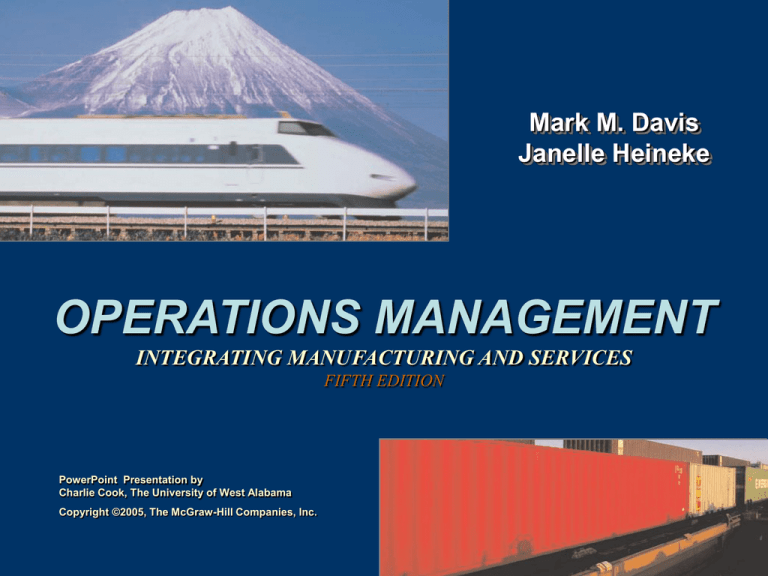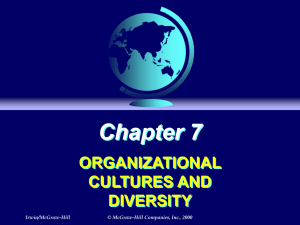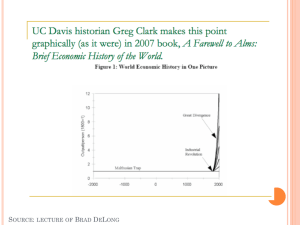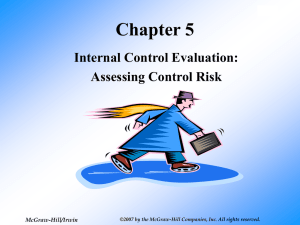
Mark M. Davis
Janelle Heineke
OPERATIONS MANAGEMENT
INTEGRATING MANUFACTURING AND SERVICES
FIFTH EDITION
PowerPoint Presentation by
Charlie Cook, The University of West Alabama
Copyright ©2005, The McGraw-Hill Companies, Inc.
CHAPTER
5
Integrating Manufacturing
and Services
PowerPoint Presentation by Charlie Cook
The University of West Alabama
Copyright © 2005 The McGraw-Hill Companies. All rights reserved.
CHAPTER OBJECTIVES
• Demonstrate the importance of aligning the goods and services
components of the product bundle.
• Present several frameworks that provide insights for integrating
manufacturing and services.
• Introduce alternative approaches for using services to create value
for manufacturing firms.
• Illustrate how services can add value to goods.
Copyright © 2005 The McGraw-Hill Companies. All rights reserved.
McGraw-Hill/Irwin 5–3
Managerial Issues
• Trend toward a single global economy
–Increased availability and quality of products
• Shorter product life cycles
–Rapid commoditization of products
• Products are now a bundle of benefits
–Services in support of its goods has become a means of
differentiating a firm’s products.
Copyright © 2005 The McGraw-Hill Companies. All rights reserved.
McGraw-Hill/Irwin 5–4
Managerial Issues
• Bundle of Benefits
–The overall product offering that includes goods and
services.
–Order Qualifiers
• The minimum characteristics of a firm or its products
that a firm must have to be considered as a source of
purchase.
–Order Winners
• The characteristics of a firm that distinguish it from its
competition so that it is selected as the source of
purchase.
Copyright © 2005 The McGraw-Hill Companies. All rights reserved.
McGraw-Hill/Irwin 5–5
The Increasing Role of Service in
Manufacturing
• Examples of Services
– Warranties
– Customer support
– Leasing, licensing, and rentals
• Service adds value (and profitability)
– Service margins can be greater than associated
product margins
Copyright © 2005 The McGraw-Hill Companies. All rights reserved.
McGraw-Hill/Irwin 5–6
Increased Emphasis on Services
Exhibit 5.1
Copyright © 2005 The McGraw-Hill Companies. All rights reserved.
McGraw-Hill/Irwin 5–7
Defining Levels of Added Service:
Little “s”
• Little “s,” or Operational, Services
– Services from primarily within the firms’ operations
that are applied to existing products function to make
them more attractive to customers.
• Availability: speed of delivery is an important
factor in buying a product.
• Customization: modifying the standard product
offering to meet the needs of each individual
customer is now possible due to advances in
manufacturing technologies.
Copyright © 2005 The McGraw-Hill Companies. All rights reserved.
McGraw-Hill/Irwin 5–8
Defining Levels of Added Service:
Big “S”
• Big “S,” or Strategic, Services
– Services that require coordination across
organizational (functional) boundaries that exist
between within a strategic business unit (SBU),
between SBUs, or even between independent
organizations.
Copyright © 2005 The McGraw-Hill Companies. All rights reserved.
McGraw-Hill/Irwin 5–9
The Service Factory’s Roles
• Consultant
– Utilizing the expertise of factory workers to address
customer-related issues, especially with respect to
problem solving.
• Showroom
– Using the factory floor to demonstrate to customers
the technical expertise and the quality of the
processes used to manufacture goods or components.
• Dispatcher
– Using the factory for after-sales service support,
especially in solving problems with new products.
Copyright © 2005 The McGraw-Hill Companies. All rights reserved.
McGraw-Hill/Irwin 5–10
Customer’s Activity Cycle
Source: Reprinted from From Tin Soldiers to Russian Dolls: Creating Added Value through Services
Sandra Vandermerwe (Oxford, England: Butterworth-Heinemann), © 1993, with permission by Elsvier.
Copyright © 2005 The McGraw-Hill Companies. All rights reserved.
Exhibit 5.2
McGraw-Hill/Irwin 5–11
Integration of Manufacturing and Services
• The Customer’s Activity Cycle (CAC)
Component
Actions
Pre-purchase activities
Being responsive to customer
inquires and the ability to
demonstrate technical expertise.
Purchase activities
Actual sale and delivery of the
product and collecting payment.
Post-purchase activities
After-sales service and product
warranties
Copyright © 2005 The McGraw-Hill Companies. All rights reserved.
McGraw-Hill/Irwin 5–12
Examples of Activities within
the Customer’s Activity Cycle
Exhibit 5.3
Copyright © 2005 The McGraw-Hill Companies. All rights reserved.
McGraw-Hill/Irwin 5–13
Downstream Activities
(Wise and Baumgartner)
Service Strategy
Function
Embedded Services
Specific functions that are a part of
the product itself.
Comprehensive Services
The manufactured product is
“married” to additional services.
Integrated Solutions
Combining product and services
into a seamless offering that
addresses a specific customer
requirement.
Distribution Control
Manufacturing goes downstream to
assume responsibility for product
distribution.
Copyright © 2005 The McGraw-Hill Companies. All rights reserved.
McGraw-Hill/Irwin 5–14
Additional Approaches for Integrating
Manufacturing and Services
• Demonstration of Knowledge and Expertise
– Reassuring customers by allowing them to view the
production process and to have access to production
employees.
• Improved Product Performance
– Using technology to anticipate and correct problems
before they occur or to reduce response time.
• Customer Training
– Providing product training to customers to build
product loyalty and increased use of products.
Copyright © 2005 The McGraw-Hill Companies. All rights reserved.
McGraw-Hill/Irwin 5–15
Additional Approaches for Integrating
Manufacturing and Services (cont’d)
• Customer Training
– Providing product training to customers to build
product loyalty and increased use of products.
• Expanded Product Capabilities
– Providing services in the form of additional product
capabilities that go beyond the primary function of
the product itself.
Copyright © 2005 The McGraw-Hill Companies. All rights reserved.
McGraw-Hill/Irwin 5–16
Focusing on Core Capabilities
• Core Capabilities
–Specific strengths that allow a company to achieve its
competitive priorities.
–The skill or set of skills that the operations
management function develops that allows the firm to
differentiate itself from its competitors.
• Focusing is achieved by:
–Divesting non-critical activities.
–Subcontracting ancillary activities and services.
Copyright © 2005 The McGraw-Hill Companies. All rights reserved.
McGraw-Hill/Irwin 5–17
The Impact of Technology
• The Internet
– Helps firms offer services that replace goods.
– Allows firms to offer 24 × 7 service while at the same
time being cost effective.
– Has reduced the cost of transmitting information
while increasing the speed and the amount of data
that can be sent between individuals.
Copyright © 2005 The McGraw-Hill Companies. All rights reserved.
McGraw-Hill/Irwin 5–18











